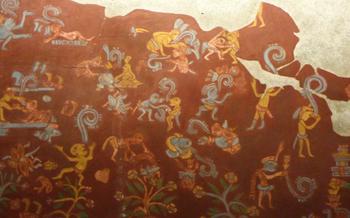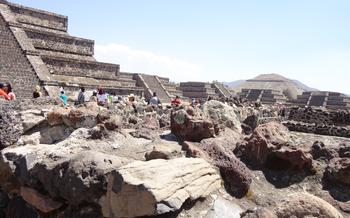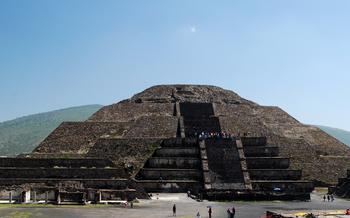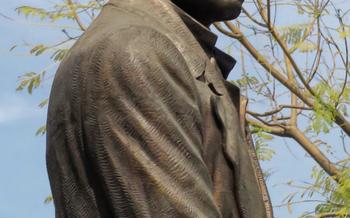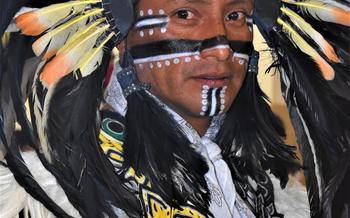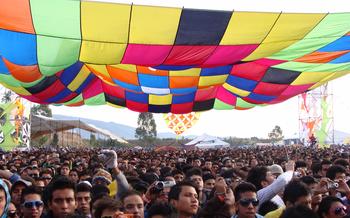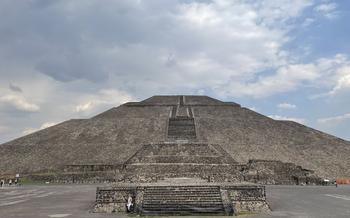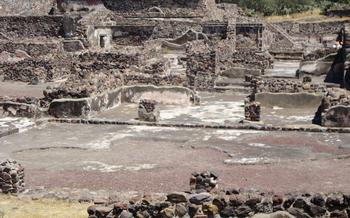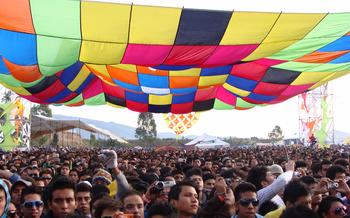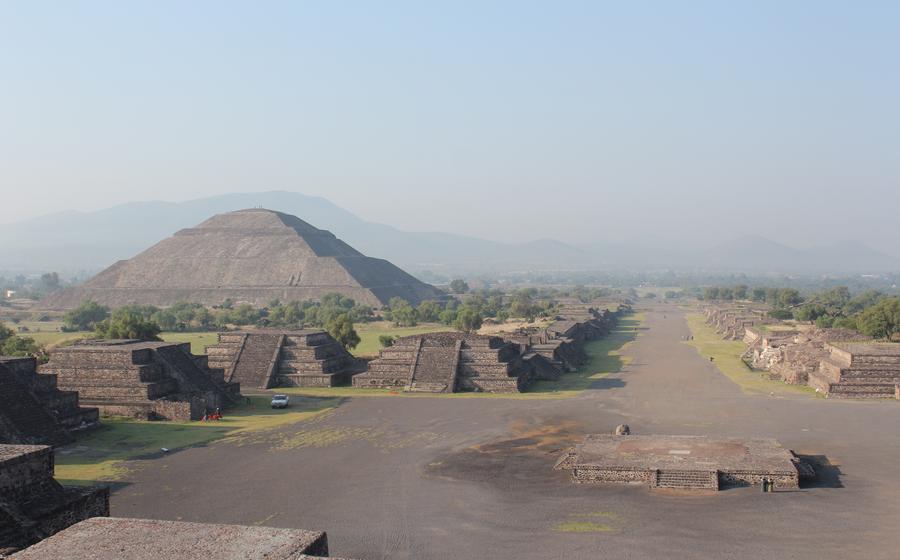
Temple of Agriculture
- Historical Significance
- Architectural Features
- Layout and Design
- Excavations and Discoveries
- Restoration and Preservation
- Visiting the Temple:
- Exploring the Surrounding Area
- Cultural Significance
- Myths and Legends
- Local Cuisine
- Shopping and Souvenirs
- Festivals and Events
- Photography Tips
- Solo Travel
- Insider Tip: The Hidden Garden of the Priests
Historical Significance
Teotihuacan, a Mesoamerican metropolis that flourished between 100 BC and 750 AD, was once the largest city in the Americas. Among its most iconic structures is the Temple of Agriculture, a testament to the city's agricultural prowess and religious beliefs. Built around 200 AD, the temple served as a sacred space for rituals related to agriculture, fertility, and the cyclical nature of life. Its prominent location within the city underscores its importance, not only as a religious center but also as a symbol of the city's dependence on and reverence for agriculture.
The temple's cultural significance extends beyond its role in agricultural practices. It embodies the sophisticated astronomical knowledge of the Teotihuacanos, who carefully aligned the temple's axis with celestial events, particularly the summer solstice. This alignment suggests a deep connection between agriculture, religion, and the cosmos, reflecting the Teotihuacanos' belief in the interconnectedness of the natural and spiritual worlds.
The city's eventual abandonment remains a mystery, with theories ranging from environmental factors like drought and deforestation to political turmoil and internal strife. However, the legacy of Teotihuacan and the Temple of Agriculture endures, serving as a testament to the ingenuity and cultural achievements of this ancient civilization.
Architectural Features
The Temple of Agriculture stands out for its unique architectural style, distinct from other structures in Teotihuacan. Constructed using adobe bricks and lime mortar, the temple features a series of superimposed platforms, each adorned with intricate murals and sculptures. The exterior walls are covered in colorful murals depicting agricultural scenes, including farmers tending to their crops, harvesting, and offering their bounty to the gods. These murals provide valuable insights into the agricultural practices and rituals of the Teotihuacanos.
The temple's interior is equally impressive, showcasing a series of chambers and passageways decorated with intricate carvings and bas-reliefs. These carvings depict various deities, mythical creatures, and symbols associated with agriculture and fertility. The temple's symbolism extends beyond its murals and sculptures, as its overall design and orientation are believed to be aligned with celestial bodies and agricultural cycles. This alignment suggests that the temple played a significant role in regulating the agricultural calendar and ensuring successful harvests for the Teotihuacanos.
Layout and Design
The Temple of Agriculture is situated in the heart of Teotihuacan, forming an integral part of the city's meticulously planned layout. Its alignment with celestial bodies and agricultural cycles reveals the Teotihuacanos' profound understanding of astronomy and their intricate connection to the natural world. The temple's position within the urban grid reflects its significance as a central hub for religious ceremonies and agricultural rituals.
The design of the Temple of Agriculture embodies symmetry and geometric patterns, showcasing the advanced architectural prowess of the Teotihuacanos. Its rectangular shape, divided into three sections, mirrors the tripartite division of the cosmos in ancient Mesoamerican beliefs. The temple's facade is adorned with intricate carvings and murals depicting agricultural scenes, underscoring its dedication to the cultivation and sustenance of life.
The temple's relationship to other structures and plazas within Teotihuacan reveals a sophisticated urban plan. Its proximity to the Avenue of the Dead, the city's main thoroughfare, highlights its importance as a religious and civic center. The surrounding plazas and courtyards provided ample space for gatherings, rituals, and market activities, emphasizing the temple's role as a focal point of community life.
Excavations and Discoveries
Archaeological excavations conducted at the Temple of Agriculture have shed light on the daily life and rituals of the Teotihuacanos. The temple has yielded a wealth of artifacts, offerings, and human remains, providing valuable insights into the ancient city's culture and religious practices. Among the most significant discoveries are intricately carved stone sculptures depicting agricultural scenes and deities associated with fertility and agriculture. These artifacts provide a glimpse into the religious beliefs and rituals that took place within the temple walls. Ongoing research and excavations continue to uncover new information about the Temple of Agriculture and the ancient civilization that built it.
Restoration and Preservation
The Temple of Agriculture, like many other ancient sites, has faced the challenges of time and the elements. Recognizing its cultural significance, extensive efforts have been undertaken to conserve and restore this treasured monument. Archaeological teams have meticulously worked to stabilize the temple's structure, reinforce its foundations, and protect its delicate murals from further deterioration. The Mexican government, in collaboration with international organizations, has allocated resources to ensure the ongoing preservation of this iconic site.
Balancing tourism with conservation is a delicate task. While the Temple of Agriculture attracts a significant number of visitors, measures have been implemented to minimize the impact on its fragile remains. Controlled access, designated pathways, and educational signage help guide visitors through the site while preserving its integrity. The preservation efforts extend beyond the physical structure; initiatives have been launched to document and preserve the intangible cultural heritage associated with the temple, including traditional rituals and agricultural practices that have been passed down through generations.
The Temple of Agriculture stands as a testament to the remarkable achievements of the Teotihuacanos and the enduring power of cultural heritage. Through ongoing restoration and preservation efforts, this ancient marvel continues to captivate visitors from around the world, offering a glimpse into the rich legacy of Mexico's past.
Visiting the Temple:
The Temple of Agriculture is situated in the heart of Teotihuacan, just a short distance from the Pyramids of the Sun and Moon. It is easily accessible by foot or by taking a local bus from Mexico City. The site is open to the public daily, with varying hours of operation depending on the time of year. Admission fees are minimal and include access to the entire archaeological site.
For a more comprehensive and immersive experience, guided tours are available in various languages. These tours provide in-depth insights into the history, architecture, and significance of the temple, as well as the surrounding area. Alternatively, visitors can opt for self-guided exploration, allowing them to wander through the site at their own pace and discover its secrets.
To make the most of your visit, plan your trip during the cooler months (October to April) to avoid the intense summer heat. Wear comfortable shoes suitable for walking on uneven surfaces, as you'll be doing a lot of exploring. Don't forget to bring water, sunscreen, and a hat to protect yourself from the sun.
Whether you choose to join a guided tour or explore independently, a visit to the Temple of Agriculture promises an unforgettable experience. So, step back in time, marvel at the architectural wonders, and immerse yourself in the rich history and cultural significance of this ancient site.
Exploring the Surrounding Area
In addition to the Temple of Agriculture, Teotihuacan boasts a treasure trove of other attractions and landmarks waiting to be explored. Just a short distance away, visitors can marvel at the awe-inspiring Pyramids of the Sun and Moon, two of the most iconic structures in the ancient city. The Avenue of the Dead, a grand ceremonial pathway, connects these pyramids and is lined with impressive temples, palaces, and residential compounds.
Beyond the main archaeological zone, visitors can discover hidden gems such as the Temple of Quetzalcoatl, dedicated to the feathered serpent god, and the Butterfly Palace, adorned with vibrant murals depicting butterflies and other insects. The surrounding area also offers opportunities for hiking, biking, and horseback riding, allowing visitors to immerse themselves in the natural beauty of the region.
Day trips from Mexico City are easily arranged, providing a convenient way to explore Teotihuacan and its surroundings. Guided tours are available for those who prefer a more structured experience, while independent travelers can rent bicycles or hire a car to explore at their own pace. Whether you choose to delve into the depths of Teotihuacan's archaeological wonders or simply soak in the beauty of its natural surroundings, the surrounding area offers an array of experiences to enrich your visit.
Cultural Significance
The Temple of Agriculture holds immense cultural significance in Mexican heritage. It stands as a testament to the ingenuity and agricultural prowess of the ancient Teotihuacan civilization. The temple's intricate murals and sculptures depict various agricultural scenes, highlighting the importance of farming and its deep roots in Mexican culture.
Today, the Temple of Agriculture serves as a symbol of Mexican identity and pride. It attracts numerous visitors who come to admire its architectural grandeur and learn about its historical significance. The temple's enduring legacy is a reminder of the profound connection between the land and its people, a connection that continues to shape Mexican culture and traditions to this day.
The Mexican government actively promotes and preserves the Temple of Agriculture as a national treasure. Through restoration projects and educational initiatives, they aim to protect this ancient monument and ensure its significance is passed on to future generations. The temple's cultural value transcends time, serving as a bridge between the past and the present, uniting Mexicans in their appreciation for their rich cultural heritage.
Myths and Legends
The Temple of Agriculture is shrouded in myths and legends that have been passed down through generations. According to local folklore, the temple was built by the gods to teach humans the art of agriculture. Legends speak of a time when the gods descended from the heavens and shared their knowledge of farming with the people of Teotihuacan. These myths highlight the deep connection between the temple and the agricultural practices that sustained the ancient city.
One of the most famous legends associated with the temple is the story of the "Feathered Serpent." This mythical creature, often depicted with the body of a serpent and the feathers of a bird, is said to have played a crucial role in the creation of the temple. According to legend, the Feathered Serpent guided the people of Teotihuacan to the site where the temple would be built and helped them to construct it.
Another popular legend tells of a "hidden treasure" buried beneath the temple. It is said that this treasure consists of gold, silver, and precious jewels that were offered to the gods as sacrifices. Many have searched for this hidden treasure over the years, but none have ever been successful. The legend of the hidden treasure adds an air of mystery and intrigue to the Temple of Agriculture, making it even more alluring to visitors.
These myths and legends are deeply embedded in the local culture and identity of Teotihuacan. They reflect the importance of the temple in the lives of the ancient Teotihuacanos and continue to inspire and fascinate visitors to this day.
Local Cuisine
When visiting Teotihuacan, indulging in the local cuisine is a must. The city offers a variety of traditional Mexican dishes that showcase the rich flavors and culinary traditions of the region. From street food stalls to authentic restaurants, there are plenty of options to satisfy your taste buds.
Must-Try Dishes:
- Barbacoa: Slow-cooked lamb or goat, a specialty of the region.
- Pulque: A traditional fermented beverage made from the sap of the maguey plant.
- Escamoles: A delicacy made from ant eggs, considered a culinary treasure.
- Nopales: Edible cactus paddles, often used in salads, soups, and stews.
- Tlacoyos: Thick corn tortillas filled with beans, cheese, or meat.
Local Markets:
- Mercado de Artesanías: A vibrant market selling handicrafts, souvenirs, and local delicacies.
- Mercado La Merced: A traditional market offering a wide variety of fresh produce, meats, and traditional dishes.
Street Food:
- Tacos al Pastor: Spit-roasted pork tacos, a popular street food delicacy.
- Elotes: Grilled corn on the cob, often topped with chili powder, lime, and cheese.
- Tostadas: Fried corn tortillas topped with various fillings, including seafood, meats, and vegetables.
Tips for Food Lovers:
- Be adventurous: Don't be afraid to try new dishes and flavors.
- Try the street food: It's a great way to sample local favorites at affordable prices.
- Visit the markets: Explore the vibrant markets for fresh produce, traditional ingredients, and handmade treats.
- Ask for recommendations: Locals are always happy to share their favorite food spots.
Shopping and Souvenirs
In Teotihuacan, you'll find a vibrant collection of local markets and shops selling a diverse range of souvenirs and handicrafts. These treasures are a testament to the rich cultural heritage and artistic traditions of the region. From intricate textiles and pottery to colorful masks and handwoven baskets, there's something to suit every taste and budget.
When shopping for souvenirs, be sure to visit the Mercado de Artesanías, located just a short walk from the Temple of Agriculture. Here, you'll find a labyrinth of stalls and vendors selling an array of handcrafted goods, including traditional Mexican clothing, jewelry, and home décor. The market is a great place to practice your bargaining skills and support local artisans directly.
Look out for unique pieces made from local materials such as obsidian, a volcanic glass that was highly valued by the ancient Teotihuacanos. You might find stunning obsidian jewelry, sculptures, or decorative items that make for truly special souvenirs.
Remember to bring cash as many vendors may not accept credit cards. It's also important to be respectful and ask permission before taking photos of people or their crafts. Your purchases not only support the local economy but also contribute to preserving the cultural traditions of Teotihuacan.
Festivals and Events
Teotihuacan comes alive during its annual festivals and events, offering a unique blend of culture, history, and vibrant celebrations. The most notable event is the Spring Equinox Festival, held on March 20-21, when thousands of visitors gather to witness the sun rising perfectly aligned with the Pyramid of the Sun. This spectacle is accompanied by traditional ceremonies, music, and dance performances, creating a truly magical atmosphere.
Other notable events include the Day of the Dead celebration in early November, when locals honor their departed loved ones with colorful altars, offerings, and festivities. The Feast of San Juan Bautista, held on June 24, is another popular event, featuring processions, traditional dances, and lively music.
Attending these festivals is a fantastic way to immerse yourself in the cultural traditions of Teotihuacan and experience the city's vibrant energy. Be sure to plan your visit accordingly to coincide with these special events and make your trip even more memorable.
Photography Tips
The Temple of Agriculture, with its awe-inspiring architecture and intricate details, presents a captivating subject for photography enthusiasts. To capture the essence of this ancient monument, consider the following tips:
-
Golden Hour Magic: Arrive at the temple during the golden hours, just after sunrise or before sunset, to harness the warm, diffused light that casts a magical glow on the structures. This soft light enhances the textures and colors of the temple, creating stunning photographs.
-
Experiment with Angles: Don't just stick to the frontal view; explore different angles to add depth and interest to your shots. Capture the temple's towering presence from below, emphasizing its scale against the vast sky. Experiment with side angles to reveal intricate architectural details often missed from a straight-on perspective.
-
Lenses and Settings: A wide-angle lens allows you to capture the temple's grandeur in its entirety, while a telephoto lens can zoom in on specific features and details. Adjust your camera settings to suit the conditions, using a tripod for stability and slow shutter speeds to blur any movement, such as clouds or foliage.
-
Composition and Perspective: Play with composition to create visually appealing images. Incorporate elements like the surrounding landscape, vegetation, or people to add context and depth. Experiment with different perspectives, such as shooting from a low angle to create a sense of scale or from a high vantage point to showcase the temple's relationship to its surroundings.
-
Capture the Spirit: Beyond technical aspects, strive to capture the spirit and essence of the Temple of Agriculture. Look for unique details, such as weathered surfaces, intricate carvings, or the play of light and shadow. These elements add character and narrative to your photographs, transforming them into evocative representations of this ancient site.
Solo Travel
Traveling solo to the Temple of Agriculture can be a rewarding and enriching experience. To ensure a safe and enjoyable visit, consider the following tips:
-
Safety First: Always be aware of your surroundings and take necessary precautions. Avoid walking alone at night and stick to well-lit areas.
-
Guided Tours: Joining a guided tour is an excellent way to learn more about the temple's history and significance. You'll also have the opportunity to meet other travelers and share the experience.
-
Embrace the Adventure: Solo travel offers a unique chance for self-discovery and personal growth. Embrace the adventure, step out of your comfort zone, and enjoy the freedom to explore at your own pace.
-
Connect with Locals: Engage with local vendors, artisans, and guides to learn about their culture and traditions. These interactions can lead to unexpected encounters and memorable experiences.
-
Document Your Journey: Capture the essence of your solo adventure through photography, journaling, or vlogging. Share your experiences with others and inspire them to embark on their own solo journeys.
Insider Tip: The Hidden Garden of the Priests
Beyond the main temple complex lies a hidden gem known as the Garden of the Priests. This secluded spot, once reserved for the elite, offers a peaceful retreat and a glimpse into the daily life of the Teotihuacanos. Wander through the lush gardens, admire the intricate murals depicting agricultural rituals, and soak in the tranquil atmosphere. As you explore this hidden oasis, let your imagination transport you back in time and experience the sacred rituals that once took place here.
